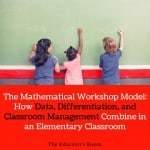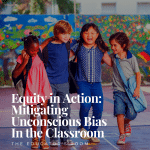By Jeffrey Benson
At staff meetings in most schools, the subject area teachers sit among their peers. They sit with ones who most understand their struggles to convey the content and skills specific to their disciplines: PE with PE, science with science, arts with arts. As a consultant to schools that work with challenging students, this makes sense to me, these small islands of solidarity. Even though all the teachers may be helping the students learn to keep organized binders or to manage the stress of standardized testing, no one but the math teachers know how hard it is to teach division with fractions.
In fact, math is almost always the most misunderstood subject in the room. The rest of the faculty don’t “do” math. When there is professional development requiring numerical reasoning, the teachers roll their eyes and quickly search for the calculators on their phones.
I hear no sounds of protest from the math department when it is said that math is all about being exact and linear—humanities are not. Math is about answers that are right and wrong—not like the arts. All too often, the math teachers sit in silent complicity, as if they enjoy their strange isolation. But math is also an art; numbers are as symbolic as black birds in poetry. The possibilities of math—of quantitative reasoning—have been suppressed and tortured into endless worksheets and quizzes that can be quickly scored. This status quo undermines cross-discipline dialogue and project based learning. It feeds into fragmented schooling and high stakes assessments.
But it doesn’t have to be this way. Math teachers scattered about the country are breaking the mold, and showing us a vision of how all of our subject disciplines can support creativity and communication. What if these math teachers became the majority? And what if the humanities departments succumbed to the worst aspects of standardized curriculum and testing? If these disciplines traded places, we might hear a student give the following report:
“Humanities is so boring! For instance, there’s only one correct way to spell a word—my teacher says that spelling is not a matter of opinion. My teacher tells me to identify the word in a sentence that is a pronoun—apparently there are words that are pronouns and ones that aren’t. I am told that there are fragments and there are complete sentences, and the difference is clear. If I am talking about a novel we have read, I have to tell the facts in the exact order they happened. There are rules for how you are supposed to use commas and apostrophes. I have to capitalize some words and not others—as if that really makes a difference in being Understood most of the Time. Those are the rules, I am told. People seem to care that I know what capital city belongs to what country, and you can’t mix those up! My teacher says that some books are too hard for us to read, and some books are too easy for us, because you are supposed to read certain books at a certain age—it’s developmental.
My math class is where I really get to think. Here’s some of the stuff I have done;
–I made a poster explaining when it would be best to say something was “one third” and when it would be best to say it was 33%. It isn’t always clear when you should use decimals or fractions or percentages to describe a portion of something. My teacher says understanding how to communicate a mathematical idea is so much about your audience and your intentions.
–I had to look at baseball statistics about shortstops and defend my reason why one of them was the best choice to get a 5 year contract. Wow, that was hard! My best friend and I had very different opinions. My teacher gave us good grades for how well we prioritized the different data. He said there was no one right answer, of course—just like real life!
–My teacher put an equation on the board and said there were a few ways to solve it. He wanted us to pick a way to solve it that would be best if our life depended on getting it right, a method if we wanted to have the most fun trying a wacky way, and a method that was the quickest, even if it might sometimes cause you to make a careless error.
–He showed us a shape we had never seen before. We had to experiment with rulers and protractors and calculators and come up with the area—and then we had to come up with a formula we could remember. I love when he says, “Try more experiments. That’s what math is about.”
–My small group was given a big jar of pennies. We had to come up with 5 different ways we could estimate the number of pennies in the jar. He is giving the same problem to the kids in a class two grades below mine and two grades above mine.
My math teacher says humanities classes could be fun too, but mostly they are taught like math classes that did only number-crunching right-and-wrong drills. He says humanities classes could be filled with opinions, creative writing, lots of discussions, and using evidence to back up our own theories. He even says there are people who have a love of literature the way we have a love of numeracy. Yeah, right.”
This student lives in a fictional world. But not an impossible one. Your school can take one bold step into a different view of math: hold a “Numeracy Celebration:”
• Set up estimation stations around the school (“How many books in the library?”)
• Label the heights of doorways and the square inches of student desks
• Use stairway risers to display skip counting/multiplication steps
• Create bulletin boards with up-to-date sports statistics
• Measure and publicize the decibel levels in the hallways during transitions
• Analyze in social studies classes the school’s materials budget
Have fun with numbers. Build a school culture that finds the precision, creativity, and beauty in every subject. And do try to sit with the math teachers at staff meetings.
Bio:
Jeffrey Benson has worked in almost every school context in his 35 years as an educator, from elementary school through graduate programs. He has been a consultant to public and private schools, mentored teachers and principals in varied school settings, and has written on many school-based issues. Benson’s new book, Hanging In: Strategies for Teaching the Students Who Challenge Us Most (ASCD, 2014), shows educators the value of tenacity and building connections when teaching the students who most need our help. You can learn more at www.jeffreybenson.org or connect with him on Twitter at @JeffreyBenson61.




